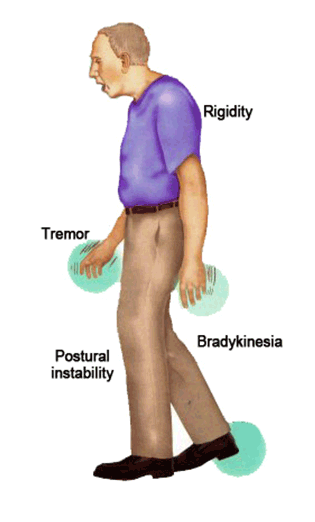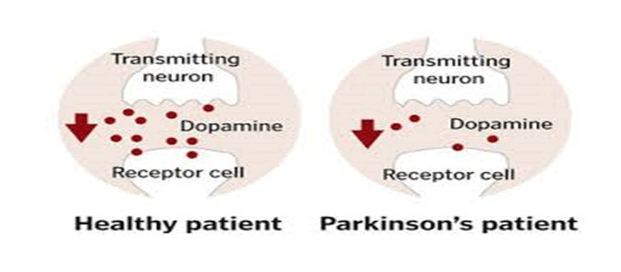What is Parkinson’s Disease?
Parkinson’s disease is a group of conditions called motor system disorders. Four early symptoms are as follows:
- Tremor: shivering in the hands, arms, legs, jaw and face.
- Rigidity: stress or strain on the limbs and the back.
- Bradykinesia: slow movements.
- Postural instability: deterioration of balance and body coordination.

These symptoms may cause the patients some difficulty in walking, talking or doing light tasks. This disease is a chronic and progressive disease. It is not a contagious illness. It is a condition whereby a person’s muscle control deteriorated so badly that person is not able to manage himself.
The researchers have identified a brain cell damage that leads to a reduction in a chemical called dopamine as the main cause of this disease.

What is the treatment for Parkinson’s Disease?
Currently Parkinson’s disease cannot be cured, but the symptoms can be controlled through medicines or surgery . The effects of the disease to each patients are different therefore treatment must be tailored for each individual.
What is the type of Anti Parkinson?
|
Levodopa
|
Dopamine agonist
|
MAO inhibitor
|
COMT inhibitor
|
Anticholinergics
|
Other
|
|---|---|---|---|---|---|
| Increase dopamine level in the brain | Mimic or copy the function of dopamine in the brain | Prolong the effects of dopamine in the brain by preventing its breakdown | Allow a larger amount of levodopa to reach the brain, which raises dopamine levels there | Restore the balance between the two brain chemicals, dopamine and acetylcholine, by reducing the amount of acetylcholine | |
|
Example of Anti-Parkinson’s Medicines
|
|||||
| Madopar® Sinemet® Stalevo® |
Pramipexole Ropinirole Rotigotine Patch Bromocriptine Piribedil |
Selegiline | Entacapone | Benzhexol | Amantadine |
What are the common side effects?
|
Levodopa
|
Dopamine agonist
|
MAO inhibitor
|
COMT inhibitor
|
Anticholinergics
|
Other
|
|---|---|---|---|---|---|
| Low blood pressure, nausea, vomiting, confusion, light-headedness, low appetite | Low blood pressure, nausea, leg swelling, compulsive behavior, sleep attack | Nausea, dry mouth, light-headedness, constipation | Diarrhea , discolored urine, hallucination, enhance the side effect of levodopa | Confusion, memory issue, hallucination, dry mouth, blurry vision, urinary retention | Nausea, confusion, light-headedness, difficulty sleeping, , dry mouth, loss appetite, low blood pressure |
What are the special instructions for patients taking parkinson’s medicines?
- Tell your doctor and pharmacist if you are taking certain medicines , herbal preparations, nutritional products, or vitamins.
- You must tell your doctor and pharmacist if you are allergic to any other medicines or if your allergic occur while taking this medicine.. Allergic symptoms include one or more of the following: swelling of the face / eyes / lips, difficulty in breathing or skin irritation rash that spreads.
- Be careful while driving or operating machine because these medicines may cause drowsiness or blurring of vision.
- Do not stop taking the medicine abruptly.
- Tell your doctor if you are breast-feeding, pregnant or may become pregnant during treatment.
- These medicines may cause dryness of the mouth. You can try sucking sweets to reduce the problem.
- Dizziness or fainting may occur, especially when waking up from a sitting or lying position. Waking up slowly may help prevent these side effects from occurring. Check with your doctor if your condition persists or worsens
How to cope with Parkinson’s disease?
Managing Parkinson’s disease can be complicated, but it’s nothing you can’t handle. Here are some tips to manage the symptoms of Parkinson’s disease.
- Exercise. Exercise can help make living with Parkinson’s disease easier by:
- Helping you feel more in control of your movements
- Reducing gait problems and muscle/joint injuries
- Improving flexibility
- Increasing muscle strength and balance
- Increasing energy, stamina, and cardiovascular health
But, remember to consult your doctor before engaging with any physical activities.
- Nutrition. Proper nutrition can reduce the risk of four common reasons for hospitalization among people living with Parkinson’s disease: bone fracture, dehydration, bowel impaction, and weight loss. Make these nutrition habits part of your management strategy:
- Drink six to eight glasses of water a day, even if you aren’t thirsty.
- Eat natural laxatives — prunes, vegetables, and foods high in fiber — to prevent or relieve constipation.
- Eat something cold and sour before a meal to help prevent dry mouth.
- Talk to your doctor and pharmacist about any food-specific issues related to your medicines. For example, meals high in protein may interfere with the absorption of levodopa.
- Sleep. Parkinson’s disease can include symptoms that interfere with your sleep. Here are some tips on how you could get a good night rest:
- Avoid alcohol, caffeine, and other stimulants — especially in the evenings.
- Minimize fluid intake in the hours before bedtime.
- Establish a regular routine by going to bed and waking up at the same time each day.
- Avoid oversleeping.
- Create a comfortable, peaceful environment in your bedroom.
- Avoid watching TV, reading, and eating in bed.
- Support. Living with Parkinson’s disease can bring about a wide range of emotions, from the shock of diagnosis to depression, anger and frustration with physical challenges. These are the steps that you could take to deal with these emotional challenges :
- Maintain open and honest communication with your family, friends, and healthcare providers.
- Join the support group such as Malaysian Parkinson’s Disease Association to share common experiences and feelings.
- Find local social workers and counselors who can provide helpful resources in dealing with the emotional ups and downs of Parkinson’s disease.
References
- Books:
- Parkinson’s Disease Medication by David Houghton et al from National Parkinson Foundation (NPF) Educational Books
- Guidelines:
- Consensus Guidelines for the Treatment of Parkinson’s Disease 2012
- Canadian Guidelines on Parkinsons’s Disease by Canadian Journal of Neurological Sciences 2012
- Website:
- http://www.parkinsoninfo.my/
- http://www.parkinson.org/
- http://www.parkinsons.org.uk/
- http://www.webmd.com/parkinsons-disease/
| Last Reviewed | : | 17 June 2015 |
| Writer | : | Najwana bt. Hassan |
| Accreditor | : | Yam Chiew Fong |







